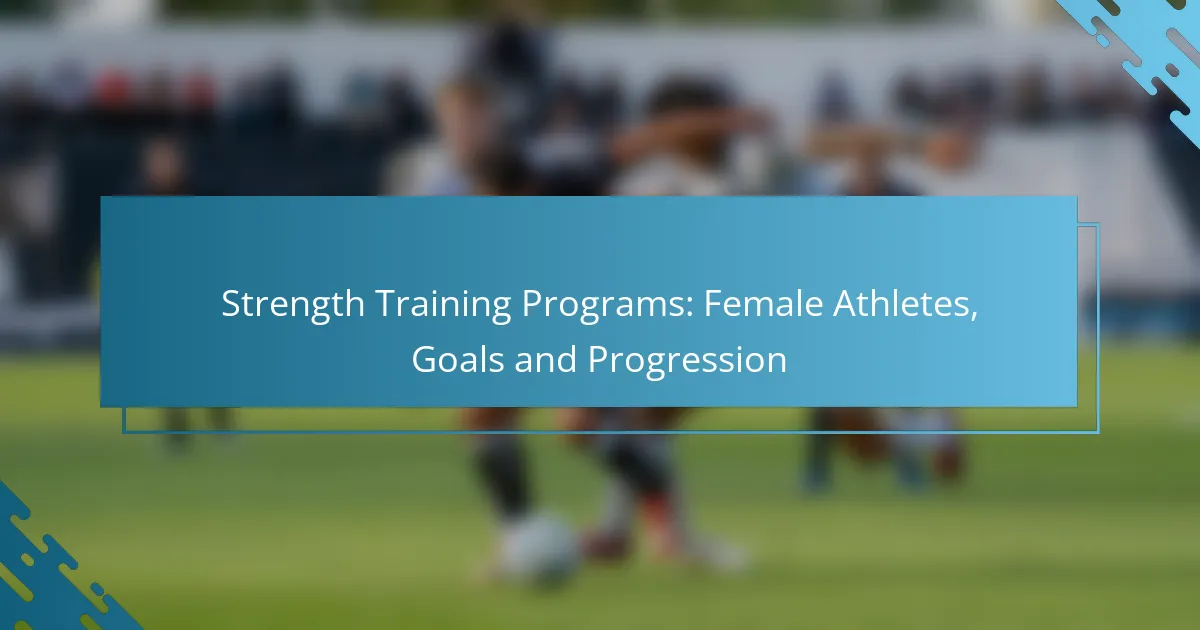Strength training programs tailored for female athletes are essential for building strength, enhancing performance, and preventing injuries. By setting clear goals and employing effective progression strategies, these programs help athletes achieve specific outcomes in muscle gain, endurance, and overall fitness while ensuring safe and sustainable development.

What Are the Best Strength Training Programs for Female Athletes?
The best strength training programs for female athletes focus on building strength, enhancing performance, and preventing injuries. These programs vary in structure and intensity, catering to different goals such as muscle gain, endurance, or overall fitness.
Programs by Nike Training Club
Nike Training Club offers a variety of strength training programs designed specifically for women. These programs include bodyweight workouts, resistance training, and high-intensity interval training (HIIT) sessions, allowing athletes to choose based on their fitness level and goals.
Each program typically ranges from 15 to 60 minutes and can be tailored to fit busy schedules. Users can access guided workouts through the app, making it easy to follow along and stay motivated.
Programs by StrongLifts
StrongLifts focuses on a simple yet effective strength training approach using compound movements. The program emphasizes exercises like squats, deadlifts, and bench presses, which are essential for building overall strength.
This program typically follows a 5×5 format, where athletes perform five sets of five repetitions for each exercise. It’s suitable for beginners and can be progressively overloaded as strength increases.
Programs by Bodybuilding.com
Bodybuilding.com provides a wide range of strength training programs tailored for female athletes, including muscle-building and fat-loss plans. These programs often include detailed workout schedules, nutrition advice, and community support.
Many programs feature a mix of free weights and machines, allowing for varied training styles. Athletes can choose programs based on their specific goals, whether it’s gaining muscle or improving athletic performance.
Programs by CrossFit
CrossFit programs for female athletes emphasize functional movements and high-intensity workouts. These programs typically include a mix of weightlifting, cardio, and bodyweight exercises, promoting overall fitness and strength.
CrossFit workouts are scalable, meaning they can be adjusted to suit different fitness levels. This flexibility makes it accessible for women looking to challenge themselves while building strength and endurance.
Programs by Women’s Health
Women’s Health magazine offers strength training programs that focus on empowering women through fitness. These programs often include a blend of strength training, flexibility, and cardio to promote well-rounded health.
Workouts are designed to be approachable and can often be done at home or in the gym. The magazine also provides tips on nutrition and recovery, ensuring athletes have a comprehensive approach to their training.

How to Set Goals for Strength Training?
Setting goals for strength training involves defining clear, actionable objectives that guide your training efforts. Effective goals help female athletes stay focused, measure progress, and achieve desired outcomes in performance and physique.
SMART Goals Framework
The SMART framework is a popular method for setting effective goals. SMART stands for Specific, Measurable, Achievable, Relevant, and Time-bound. For example, instead of saying “I want to get stronger,” a SMART goal would be “I will increase my squat weight by 10 kg in the next three months.”
When applying the SMART criteria, ensure that your goals are tailored to your individual capabilities and aspirations. This approach not only enhances motivation but also provides a clear roadmap to track progress over time.
Performance Goals vs. Aesthetic Goals
Performance goals focus on improving specific physical abilities, such as lifting heavier weights or increasing endurance. For instance, a performance goal could be completing a deadlift of 100 kg within six months. These goals often lead to functional strength improvements that benefit overall athletic performance.
Aesthetic goals, on the other hand, center around physical appearance, such as achieving a certain body composition or muscle definition. While both types of goals can coexist, it’s essential to balance them to avoid frustration. Female athletes should consider how their training aligns with both performance and aesthetic aspirations for a holistic approach to strength training.

What Are Effective Progression Strategies?
Effective progression strategies in strength training for female athletes focus on gradually increasing the intensity, volume, or complexity of workouts. This approach ensures continual adaptation and improvement while minimizing the risk of injury.
Progressive Overload Techniques
Progressive overload involves systematically increasing the demands placed on the body during training. This can be achieved by increasing weights, adding repetitions, or enhancing workout frequency. For example, if an athlete is currently lifting 50 kg for 8 reps, they might aim to lift 55 kg for the same reps in the following weeks.
Common methods of implementing progressive overload include adjusting the load, modifying rest periods, or incorporating advanced techniques like supersets or drop sets. It’s crucial to listen to the body and avoid increasing intensity too quickly, as this can lead to overtraining or injury.
Periodization Models
Periodization is a structured approach to training that involves dividing the training cycle into distinct phases, each with specific goals. Common models include linear, undulating, and block periodization, which help athletes peak at the right time for competitions or events.
For instance, linear periodization might start with higher volume and lower intensity, gradually shifting to lower volume and higher intensity as the competition approaches. This method allows for recovery and adaptation, ensuring athletes can perform at their best when it matters most.

What Equipment Is Needed for Strength Training?
Strength training requires a variety of equipment to effectively build muscle and improve performance. The choice of equipment often depends on individual goals, available space, and budget.
Dumbbells and Kettlebells
Dumbbells and kettlebells are versatile tools for strength training, suitable for various exercises targeting different muscle groups. They allow for a wide range of movements, from basic lifts to complex exercises that engage multiple muscles.
When selecting dumbbells, consider adjustable options that can accommodate different weights, typically ranging from 2 kg to 30 kg. Kettlebells, on the other hand, come in various sizes, with common weights between 4 kg and 32 kg, making them ideal for both beginners and advanced athletes.
Resistance Bands
Resistance bands are lightweight and portable, making them an excellent choice for strength training, especially for those with limited space. They come in various resistance levels, allowing users to progressively increase difficulty as they gain strength.
These bands can be used for a variety of exercises, including squats, presses, and rows. When purchasing, look for a set that includes bands of different thicknesses, typically ranging from light to heavy resistance, to accommodate different exercises and fitness levels.
Barbells and Weight Plates
Barbells and weight plates are essential for serious strength training, particularly for compound lifts like squats, deadlifts, and bench presses. A standard Olympic barbell weighs around 20 kg and can support a significant amount of weight with the addition of plates.
When selecting weight plates, consider those that are color-coded or labeled in kilograms or pounds for easy identification. A well-rounded set might include plates ranging from 1.25 kg to 25 kg, allowing for gradual weight increases as strength improves.

How to Choose a Strength Training Program?
Choosing a strength training program involves understanding your current fitness level and defining your personal goals. A well-selected program aligns with your abilities and aspirations, ensuring effective progression and motivation.
Assessing Fitness Level
Start by evaluating your current strength, endurance, and overall fitness. Consider factors such as your experience with weight training, any previous injuries, and how often you currently exercise. This assessment helps in selecting a program that matches your capabilities.
Common methods for assessing fitness include performing basic strength tests, such as push-ups or squats, and tracking how many repetitions you can complete. You can also consult with a fitness professional for a more comprehensive evaluation.
Identifying Personal Goals
Clearly defining your personal goals is crucial for selecting the right strength training program. Goals may include building muscle, increasing endurance, improving athletic performance, or enhancing overall health. Each goal requires a different approach to training.
For example, if your aim is to build muscle, focus on programs that emphasize progressive overload and compound movements. Alternatively, if you want to enhance endurance, consider programs that incorporate higher repetitions with lighter weights. Make sure your goals are realistic and achievable within a reasonable timeframe.
